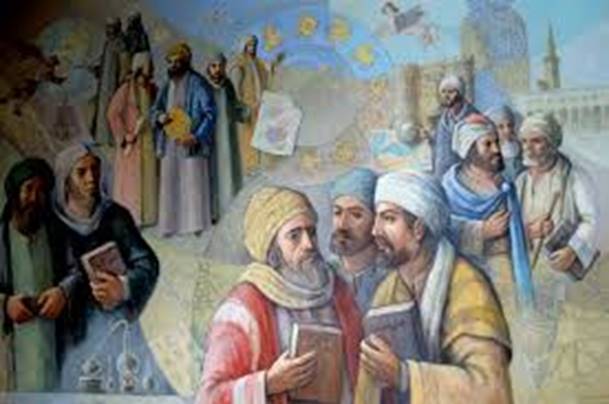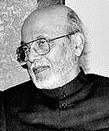

A civilization is a corpus of humankind held together by faith or covenant, knit together by legal, political and social structures, sharing a culture and producing at the higher levels works of literature, art, architecture, ideas, discoveries, and inventions – Image Barjeel Art Foundation
Is Muslim Civilization Committing Suicide? A Historical Perspective
By Dr Nazeer Ahmed
Concord, CA

Civilizations implode from within. It was Toynbee who once wrote: “Civilizations commit suicide. They are not murdered.” Is the Muslim civilization committing suicide? Is the fall of Muslim civilization more a product of ethical implosion than a deficiency of scientific prowess? Is character more of a determinant in the devolution of a civilization than scientific advancement?
Philosophers through the ages have defined the term civilization in myriad ways. A modern definition becomes challenging when we remember that Muslims constitute one-fourth of all human beings alive on this planet. Each region has its own historical trajectory. Would a single definition be acceptable to a Nigerian, an Iranian, a Malaysian, and a Pakistani?
For our distinguished readers, I offer a definition: A civilization is a corpus of humankind held together by faith or covenant, knit together by legal, political and social structures, sharing a culture and producing at the higher levels works of literature, art, architecture, ideas, discoveries, and inventions.
Faith in a transcendental idea is the cement that holds a civilization together. It need not be religion in the narrow sense defined by Samual Huntington and his absurd idea of a Clash of Civilizations. The Greek civilization thrived with the belief in the primacy of human reason. The Chinese civilization thrived on the ethical ideas of Confucius which are not necessarily religious.
The Muslim civilization appeared on the canvas of world history like a flash of light in the seventh century. At its core was faith in the idea of Tawhid, in other words, the unity of God and the brotherhood of man. The human was created to know, serve, and worship the divine. As the Qur’an declares: Ma Khalakhtul Jinna wal ins illa le yabudoon (I created not beings of energy and beings of clay except to serve and worship). It projected the human as a moral regent, a Khalifa, mandated to create divine patterns on earth based upon universal justice.
Impelled by their core beliefs, the early Muslims threw themselves into the process of history. Their confidence made them open to ideas from the East and the West. The establishment of the Baitul Hikmah in Baghdad, the eruption of the Mu’tazila and their bruising encounter with Muslim theology, al Gazzali’s repudiation of the philosophers, and the counterarguments of Ibn Rushd are all covered in detail in our Encyclopedia, historyofislam.com.
Some students of history have claimed that the decay of Muslim science dates back to the expulsion of the Mu’tazalites from the courts of Baghdad in 846 CE. But isn’t it significant that the inductive scientific method was invented, developed and used by the Muslims after the expulsion of the Mu’tazalites from the Abbasid courts?
Similarly, others have argued that Al Gazzali’s dialectic was responsible for the decay of science in Islamic civilization. A counterargument is that the pursuit of science and technology did not die out with al Gazzali. Indeed, astronomy, mathematics, art, and architecture continued to flourish well into the eighteenth century. The rockets of Tipu Sultan (d 1799) were so advanced that they were used in the Napoleonic wars in Europe. Their usage in the Anglo-American War of 1812 during the siege of Baltimore and the bombardment of Fort McHenry provided the inspiration for the composition of the American national anthem, the Star Spangled Banner, by Francis Scott Key in 1814.
So, the question continues to haunt us: If it was not the expulsion of the Mu’tazalites or the dialectic of al-Gazzali, what brought about the fall of Muslim civilization?
In the thirteenth century, the Muslim world faced catastrophic invasions from the Mongols in the east and the Crusaders in the west. Within a span of forty years, from 1219 to 1258, a vast swath of Eurasia from Samarqand to Jerusalem was devastated.
There began an intense competition between the Buddhists, the Greek Orthodox Church based in Constantinople (today’s Istanbul), the Latin Church based in Rome, and the Muslims for the soul of the Mongols. The Muslim Sufis of Central Asia won the contest. Convinced of the innate spirituality of Islam, Baraka Khan, a grandson of Chengiz Khan, accepted Islam in 1252. Mass conversion of the Mongols followed.
Some historians tie the decay of Muslim civilization to the Mongol invasions of the thirteenth century. But if the Mongols themselves converted to Islam, and became its flag bearers and the founders of new Islamic empires, how can we argue that the Mongol invasions were responsible for the fall of Muslim civilization?
The intellectual landscape of west Asia churned after the conversion of the Mongols. The Iranian highlands became the cradle of Sufi ideas producing great sages like Mevlana Rumi, Khwaja Moeenuddin Chishti, and Shah Bahauddin Naqshband. Out of the ashes of the Mongol-Tartar invasions rose the Ottoman, the Safavid and the Moghul empires. The Islam that emerged was the Sufi Islam of the saints, more focused on the spirit, inclusive, tolerant and universal. Akbar, the great Moghul was its finest product. It was this Sufic Islam that spread through the subcontinent, Indonesia, Malaysia, south-eastern Europe and sub-Saharan Africa. If there be a second golden age in Islam, it was the period between 1550 and 1650.
We may ask here: If the innate spirituality of Islam provided a life raft for the Muslims in the thirteenth century, could it do it again today in a paradigm of a global materialist civilization wherein the dominant issues are economic?
The six-year period between 1683 and 1689 is pivotal in understanding the decay of Muslim civilization and the concomitant rise of Europe. Three epic events transpired during these momentous six years. One, Sir Isaac Newton published his laws of motion in England. Two, the Ottoman armies retreated from the second siege of Vienna having suffered their first major defeat. Third, in India, Aurangzeb published his Futuwat e Alamgiri. Islamic history changed from taqwa to fatwa, from a spiritual, inclusive, universal Sufic Islam to one based on rules and regulations. Extremism followed, showing up in more extreme forms in the rise of Shaikh Abdel Wahab of Arabia.
So, the question is: To what extent is the rise of extremism responsible for the decay of Muslim civilization?
You cannot legislate ethics and morality. Aurangzeb’s edicts failed to arrest the spreading rot in the Indian body politic. The results were manifest on the battlefield of Plassey in 1757 when Mir Jaffar betrayed Siraj ad Dawlah and walked over to Robert Clive. Bengal fell and the keys to the riches of Hindustan were handed over to the British. Would the Industrial Revolution in England be possible without the loot from Bengal?
As Allama Iqbal said in BaNg-e-Dara:
Boo-e-Gul Ley Gayi Bairun-e-Chaman Raaz-e-Chaman,
Kya Qayamat Hai Ke Khud Phool Hain Ghammaz-e-Chaman !
(The aroma of the flower gave away the secrets of the garden to orchards foreign
How calamitous! The flowers themselves became traitors to the garden.)
A re-energizing of Islamic civilization is indeed possible based on its own core values. As a student of science, I like to express my ideas in symbols, formulas and acronyms. The transformation of a civilization is multi-dimensional. So, my acronym has ten dimensions. It is summarized as “SEEC and you will find”, where the S stands for science, spirituality and service, the first E stands for Education, the second E for Economics, and the C stands for cooperation and character. For those who want to know what spirituality is, it is Iman, Adl and Ehsan. Allahu A’lam.
(The author is Director, World Organization for Resource Development and Education, Washington, DC; Director, American Institute of Islamic History and Culture, CA; Member, State Knowledge Commission, Bangalore; and Chairman, Delixus Group)

